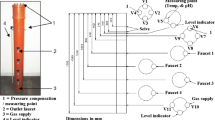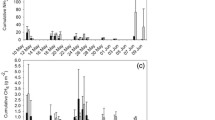Abstract
Standardized measurement protocols are required to reduce ammonia (NH3) emissions. In vitro measurement of NH3 emissions consists in trapping the emission from an emitting source in an acidic solution under controlled conditions. The objective of this study was to assess the in vitro NH3 measurement method from pig slurry with acid wet traps, as regards to the following: (i) the variation between replicates of NH3 emissions measured in vitro, (ii) the relationships between partial and accumulated emissions, and (iii) the reduction of measurement frequency. For this study, a total of 60 pig slurry samples from different animal types (sows and growing animals) were collected from commercial farms. The coefficient of variation among replicates of accumulated NH3 emission during 15 days was 6.73 %. Emissions tended to decrease with time, and an average reduction of NH3 emissions about 16 % was found in the period 96–240 h with respect to the 0–96-h period. However, samples continued emitting considerable amounts of NH3 after 360 h. Linear regression models allowed predicting emissions accumulated for 15 days using only the first 8 days (R 2 > 0.90). Reducing NH3 measurement frequency (from 24 to 48 h) did not significantly affect measured emissions (P > 0.05). The results of this study confirm that replication of measurements is required and a coefficient of variation of 10 % may be established as quality control requirement. The study also suggests that reducing the duration and frequency of measurements is a tangible option to simplify this methodology.




Similar content being viewed by others
Abbreviations
- AOAC:
-
Association of Official Analytical Chemists
- CH4 :
-
Methane
- CV:
-
Coefficient of variation, (%)
- DM:
-
Dry matter, (%)
- F:
-
Frequent
- HNO3 :
-
Nitric acid
- H2SO4 :
-
Sulfuric acid
- H3PO4 :
-
Ortophosphoric acid
- LF:
-
Less frequent
- NH3 :
-
Ammonia
- N-NH3 :
-
Ammonia nitrogen
- N2O:
-
Nitrous oxide
- OM:
-
Organic matter, (%)
- R2 :
-
Coefficient of determination
- rAE:
-
Relative absolute error
- rRMSE:
-
Relative root mean squared error of prediction
- TKN:
-
Total Kjeldahl nitrogen, (g L−1)
- VS:
-
Volatile solids (%)
References
APHA. (2005). Standard methods for the examination of water and wastewater (21st ed.). Baltimore: Centennial Edition.
Beccaccia, A., Ferrer, P., Ibáñez, M. A., Estellés, F., Rodríguez, C., Moset, V., De Blas, C., Calvet, S., & García-Rebollar, P. (2015). Relationships among slurry characteristics and gaseous emissions at different types of commercial Spanish pig farms. Spanish Journal of Agricultural Research, 13(1), 1–15.
Bittman, S., Dedina, M., Howard, C. M., Oenema, O., & Sutton, M. A. (2014). Options for ammonia mitigation: guidance from the UNECE task force on reactive nitrogen. UK. Centre for Ecology and Hydrology: Edinburgh.
Canh, T. T., Aarnink, A. J. A., Mroz, Z., Jongbloed, A. W., Schrama, J. W., & Verstegen, M. W. A. (1998a). Influence of electrolyte balance and acidifying calcium salts in the diet of growing-finishing pigs on urinary pH, slurry pH and ammonia volatilization from slurry. Livestock Science, 56, 1–13.
Canh, T. T., Aarnink, A. J. A., Schutte, J. B., Sutton, A. L., Langhout, D. J., Verstegen, M. W. A., & Schrama, J. W. (1998b). Dietary protein affects nitrogen excretion and ammonia emission from slurry of growing-finishing pigs. Livestock Science, 56, 181–191.
Canh, T. T., Aarnink, A. J. A., Verstegen, M. W. A., & Schrama, J. W. (1998c). Influence of dietary factors on the pH and ammonia emission of slurry from growing finishing pigs. Journal Animal Science, 76, 1123–1130.
Canh, T. T., Sutton, A. L., Aarnink, A. J. A., Verstegen, M. W. A., Schrama, J. W., & Bakker, G. C. M. (1998d). Dietary carbohydrates alter the faecal composition and pH and ammonia emission from slurry of growing pigs. Journal Animal Science, 76, 1887–1895.
Derikx, P. J. L., & Aarnink, A. J. A. (1993). Reduction of ammonia emission from slurry by application of liquid top layers. In: Verstegen, M. W. A., Den Hartog, L. A., Van Kempen, G. J. M., Meltz, J. H. M. European Association for Animal Production Publication; Nitrogen Flow in Pig Production And Environmental Consequences, 69, 344–349.
FAO. (2011). Livestock and environment, in: http://www.fao.org/livestock-environment/en/ Accessed 20.01.16.
Galassi, G., Colombini, S., Malagutti, L., Grovetto, G. M., & Rapetti, L. (2010). Effects of high fibre and low protein diets on performance, digestibility, nitrogen excretion and ammonia emission in the heavy pig. Animal Feed Science and Technology, 161, 140–148.
Hansen, M. N., Henriksen, K., & Sommer, S. G. (2006). Observations of production and emission of greenhouse gases and ammonia during storage of solids separated from pig slurry: effects of covering. Atmospheric Environment, 40(22), 4172–4181.
Hernández, F., Martínez, S., López, C., Megías, M. D., López, M., & Madrid, J. (2011). Effect of dietary crude protein levels in a commercial range, on the nitrogen balance, ammonia emission and pollutant characteristics of slurry in fattening pigs. Animal, 5(8), 1290–1298.
Jarret, G., Martínez, J., & Dourmad, J. (2011). Effect of biofuel co-products in pig diets on the excretory patterns of N and C and on the subsequent ammonia and methane emissions from pig effluent. Animal, 5(4), 622–631.
Jarret, G., Cerisuelo, A., Peu, P., Martínez, J., & Dourmad, J. (2012). Impact of pig diets with different fibre contents on the composition of excreta and their gaseous emissions and anaerobic digestion. Agriculture Ecosystem & Environment, 160, 51–58.
Krupa, S. V. (2003). Effects of atmospheric ammonia (NH3) on terrestrial vegetation: a review. Environmental Pollution, 124, 179–221.
Kuehl, O. R. (2001). Design of experiments (2nd ed.). Mexico: International Thomson Editores, S.A. de C.V.
Lynch, M. B., Sweeney, T., Callan, J. J., & O’Doherty, J. V. (2007). The effect of dietary barley level on volatile fatty acid concentration and manure ammonia emissions in finishing pigs. Livestock Science, 109, 236–239.
Morris, T. R. (1999). Experimental design and analysis in animal sciences. Wallingford: Ed. CABI.
Mroz, Z., Moeser, A. J., Vreman, K., Van Diepen, J. T., Van Kempen, T., Canh, T. T., & Jongbloed, A. W. (2000). Effects of dietary carbohydrates and buffering capacity on nutrient digestibility and manure characteristics in finishing pigs. Journal Animal Science, 78, 3096–3106.
Ndegwa, P. M., Vaddella, V. K., Hristov, A. N., & Joo, H. S. (2009). Measuring concentrations of ammonia in ambient air or exhaust air stream using acid traps. Journal of Environmental Quality, 38, 647–653.
O’Connell, J. M., Callan, J. J., & O’Doherty, J. V. (2006). The effect of dietary crude protein level, cereal type and exogenous enzyme supplementation on nutrient digestibility, nitrogen excretion, faecal volatile fatty acid concentration and ammonia emissions from pigs. Animal Feed Science and Technology, 127, 73–88.
O’Shea, C. J., Lynch, B., Lynch, M. B., Callan, J. J., & O’Doherty, J. V. (2009). Ammonia emissions and dry matter of separated pig manure fractions as affected by crude protein concentration and sugar beet pulp inclusion of finishing pig diets. Agriculture Ecosystems and Environment, 131, 154–160.
O’Shea, C. J., Sweeney, T., Lynch, M. B., Gahan, D. A., Callan, J. J., & O’Doherty, J. V. (2010). Effect of β-glucans contained in barley- and oat-based diets and exogenous enzyme supplementation on gastrointestinal fermentation of finisher pigs and subsequent manure odor and ammonia emissions. Journal Animal Science, 88, 1411–1420.
O’Connell, J. M., Sweeney, T., Callan, J. J., & O’Doherty, J. V. (2005). The effect of cereal type and exogenous enzyme supplementation in pig diets on nutrient digestibility, intestinal microflora, volatile fatty acid concentration and manure ammonia emissions from finisher pigs. Animal Science, 81, 357–364.
Pereira, J., Fangueiro, D., Misselbrook, T., Chadwick, D. R., Coutinho, J., & Trindade, H. (2011). Ammonia and greenhouse gas emissions from slatted and solid floors in dairy cattle houses: a scale model study. Biosystems Engineering, 109(2), 148–157.
Pereira, J., Misselbrook, T., Chadwick, D. R., Coutinho, J., & Trindade, H. (2012). Effects of temperature and dairy cattle excreta characteristics on potential ammonia and greenhouse gas emissions from housing: a laboratory study. Biosystems Engineering, 112(2), 138–150.
Portejoie, S., Dourmad, J. Y., Martínez, J., & Lebreton, Y. (2004). Effect of lowering dietary crude protein on nitrogen excretion, manure composition and ammonia emission from fattening pigs. Livestock Science, 91, 45–55.
SAS. (2008). SAS/STAT user’s guide (Release 9.2). Cary: SAS Inst. Inc.
Sokal, R. R., & Rohlf, J. F. (2002). Introduction to biostatistics (2nd ed.). Barcelona: Reverté.
Vaddella, V. K., Ndegwa, P. M., & Joo, H. S. (2011). Ammonia loss from simulated post-collection storage of scraped and flushed dairy-cattle manure. Biosystems Engineering, 110, 291–296.
Xue, S. K., Chen, S., & Hermanson, R. E. (1998). Measuring ammonia and hydrogen sulfide emitted from manure storages. Transactions of the ASAE, 41(4), 1125–1130.
Acknowledgments
This research was supported by the Spanish Ministerio de Ciencia e Innovación (project AGL2011-30023) and the Valencian Government (project ACOMP/2013/118). We thank the BABEL Project, Building Academic Bonds between Europe and Latin America. Erasmus Mundus Programme Action 2 for PhD fellowships.
Author information
Authors and Affiliations
Corresponding author
Rights and permissions
About this article
Cite this article
Antezana, W., Ferrer, P., Cambra-López, M. et al. Ammonia Emission Quantification from Pig Slurry Using Acid Wet Traps: Evaluation and Optimization of Measurement Frequency. Water Air Soil Pollut 227, 277 (2016). https://doi.org/10.1007/s11270-016-2962-4
Received:
Accepted:
Published:
DOI: https://doi.org/10.1007/s11270-016-2962-4




